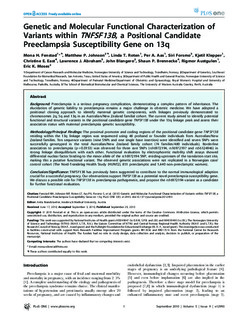| dc.contributor.author | Fenstad, Mona Høysæter | |
| dc.contributor.author | Johnson, Matthew | |
| dc.contributor.author | Roten, Linda Tømmerdal | |
| dc.contributor.author | Aas, Per Arne | |
| dc.contributor.author | Forsmo, Siri | |
| dc.contributor.author | Klepper, Kjetil | |
| dc.contributor.author | East, Christine | |
| dc.contributor.author | Abraham, Lawrence j. | |
| dc.contributor.author | Blangero, John | |
| dc.contributor.author | Brennecke, Shaun P. | |
| dc.contributor.author | Austgulen, Rigmor | |
| dc.contributor.author | Moses, Eric K | |
| dc.date.accessioned | 2015-11-10T12:40:16Z | |
| dc.date.accessioned | 2015-11-24T08:42:35Z | |
| dc.date.available | 2015-11-10T12:40:16Z | |
| dc.date.available | 2015-11-24T08:42:35Z | |
| dc.date.issued | 2010 | |
| dc.identifier.citation | PLoS ONE 2010, 5(9) | nb_NO |
| dc.identifier.issn | 1932-6203 | |
| dc.identifier.uri | http://hdl.handle.net/11250/2365382 | |
| dc.description.abstract | Background: Preeclampsia is a serious pregnancy complication, demonstrating a complex pattern of inheritance. The
elucidation of genetic liability to preeclampsia remains a major challenge in obstetric medicine. We have adopted a
positional cloning approach to identify maternal genetic components, with linkages previously demonstrated to
chromosomes 2q, 5q and 13q in an Australian/New Zealand familial cohort. The current study aimed to identify potential
functional and structural variants in the positional candidate gene TNFSF13B under the 13q linkage peak and assess their
association status with maternal preeclampsia genetic susceptibility.
Methodology/Principal Findings: The proximal promoter and coding regions of the positional candidate gene TNFSF13B
residing within the 13q linkage region was sequenced using 48 proband or founder individuals from Australian/New
Zealand families. Ten sequence variants (nine SNPs and one single base insertion) were identified and seven SNPs were
successfully genotyped in the total Australian/New Zealand family cohort (74 families/480 individuals). Borderline
association to preeclampsia (p = 0.0153) was observed for three rare SNPs (rs16972194, rs16972197 and rs56124946) in
strong linkage disequilibrium with each other. Functional evaluation by electrophoretic mobility shift assays showed
differential nuclear factor binding to the minor allele of the rs16972194 SNP, residing upstream of the translation start site,
making this a putative functional variant. The observed genetic associations were not replicated in a Norwegian case/
control cohort (The Nord-Trøndelag Health Study (HUNT2), 851 preeclamptic and 1,440 non-preeclamptic women).
Conclusion/Significance: TNFSF13B has previously been suggested to contribute to the normal immunological adaption
crucial for a successful pregnancy. Our observations support TNFSF13B as a potential novel preeclampsia susceptibility gene.
We discuss a possible role for TNFSF13B in preeclampsia pathogenesis, and propose the rs16972194 variant as a candidate
for further functional evaluation. | nb_NO |
| dc.language.iso | eng | nb_NO |
| dc.publisher | Public Library of Science | nb_NO |
| dc.title | Genetic and molecular functional characterization of variants within TNFSF13B, a positional candidate preeclampsia susceptibility gene on 13q | nb_NO |
| dc.type | Journal article | nb_NO |
| dc.type | Peer reviewed | en_GB |
| dc.date.updated | 2015-11-10T12:40:16Z | |
| dc.source.volume | 5 | nb_NO |
| dc.source.journal | PLoS ONE | nb_NO |
| dc.source.issue | 9 | nb_NO |
| dc.identifier.doi | 10.1371/journal.pone.0012993 | |
| dc.identifier.cristin | 350306 | |
| dc.description.localcode | © 2010 Fenstad et al. This is an open-access article distributed under the terms of the Creative Commons Attribution License, which permits unrestricted use, distribution, and reproduction in any medium, provided the original author and source are credited. | nb_NO |
